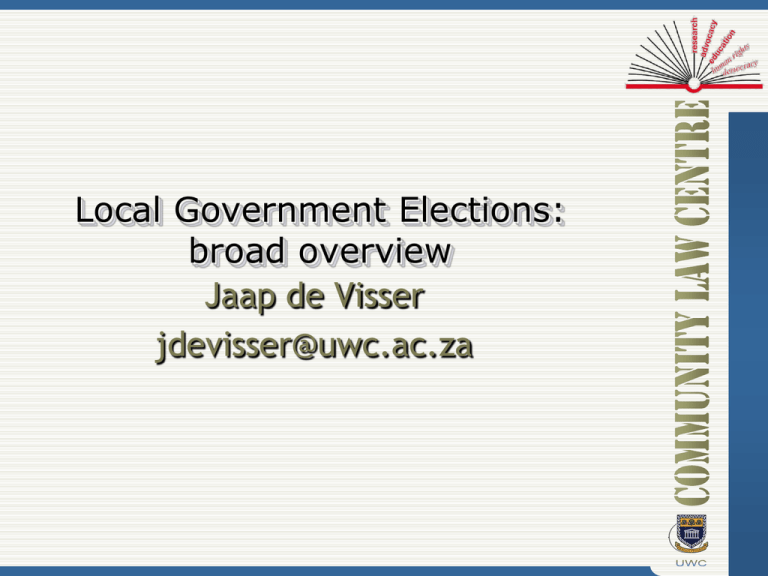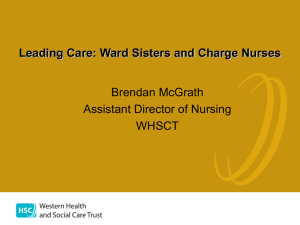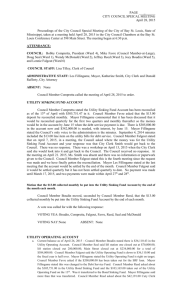Elections
advertisement

Local Government Elections: broad overview Jaap de Visser jdevisser@uwc.ac.za Two systems of local government metropolitan (City of Cape Town) non-metropolitan (rest) City of Cape Town – ‘stand alone’ municipality Everywhere else: number of local municipalities in one district municipality Two electoral systems 50% proportional representation 50% ward representation PR elections Inclusive system: no need for absolute majority to win a seat – number of seats correlates with number of votes received Political party controls party list – PR councillors are primarily accountable to the party Broad procedure Party registers with IEC (nationally or for municipality) Political party submits party list Election: party obtains percentage of vote That percentage determines no of seats IEC fills seats by taking candidates from party list into Council Vacancy? party brings another cllr, doesn’t change politics of council Ward election Candidates nominated by parties Candidates nominated by residents (independents) 50 signatures of voters in the ward Winner-takes-it-all election: whoever has most votes wins the ward (but votes for losing candidates count) Vacancy? IEC holds by-election can change majority in council City of Cape Town Two ballots Voter in CoCT Outside Cape Town 3 ballots Voter outside of City of Cape Town NB! Single Electoral Cycle: 5 ballot papers?? Appointment of local representatives to district First meeting of local council: election of district representatives Size of local municipality (no. of voters) determines size of delegation IEC manages the election How does it work? Cllr or a party submits a list to IEC parties/cllrs can submit combined lists Councillors vote during meeting: each list receives percentage of vote that percentage determines seat allocation composition reflects composition of local council Party composition of district delegation remains the same throughout term (despite by-elections) Election outcome 2006 7 out 30 municipalities outright majority rest: coalitions Now (after number of by-elections): 10 out of 30 municipalities outright majority rest: coalitions How are coalitions formed? Depends on system chosen by Province Mayor appoints coalition that lasts as long as it has support of majority in council (Executive mayor system: mayor appoints members of mayoral committee at his/her pleasure); OR Council elects an inclusive executive committee, forced to work together Executive committee system: executive (led by mayor) must broadly reflect composition of How are coalitions formed? Depends on system chosen by Province W Mayor appoints coalition that has support of majority in council C (Executive mayor system: mayor appoints A members of mayoral committee at his/her P pleasure); OR E Council elects an inclusive executive committee Executive committee system: executive (led by mayor) must broadly reflect composition of the council Executive Mayor EM appoints MAYORAL COMMITTEE Executive Mayor EM appoints MAYORAL COMMITTEE Executive Committee Council elects Executive Committee Demarcation of wards Importance Election of ward councillors Ward cllr presides over ward committee Who? Demarcation Board How? Criteria in law, e.g.: avoid fragmentation of communities accessible and safe voting stations identifiable ward boundaries but… Numbers game Number of voters = Norm Number of wards MDB cannot deviate by more than 30% E.g. norm in CPT: approx 12000/ward Challenge MDB completed ward delimitation in Western Cape new areas divided into wards (e.g. Laingsburg and abolished District Management Areas) Numbers game sometimes in ‘illogical’ ward boundaries e.g. Houtbay ≠ one ward other examples of wards straddles mountains and ‘natural’ communities (Illogical wards or ‘Rainbow Nation’?)











